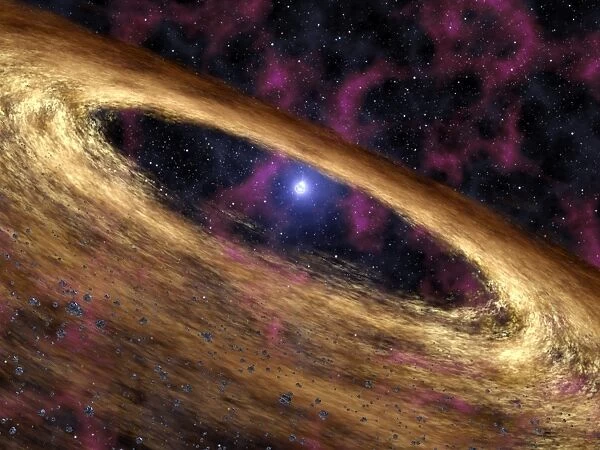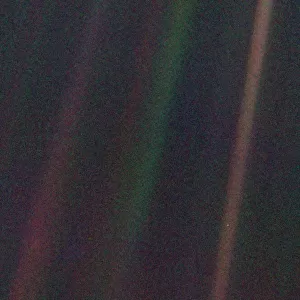Home > Stocktrek Images > Space
A type of dead star called a pulsar and the surrounding disk of rubble
![]()

Wall Art and Photo Gifts from Stocktrek
A type of dead star called a pulsar and the surrounding disk of rubble
This artists concept depicts a type of dead star called a pulsar and the surrounding disk of rubble discovered by the Spitzer Space Telescope. The pulsar, called 4U 0142+61, was once a massive star until about 100, 000 years ago when it blew up in a supernova explosion and scattered dusty debris into space. Some of that debris was captured into what astronomers refer to as a fallback disk, now circling the remaining stellar core, or pulsar. The disk resembles protoplanetary disks around young stars, out of which planets are thought to be born.
Supernovas are a source of iron, nitrogen and other heavy metals in the universe. They spray these elements out into space, where they eventually come together in clouds that give rise to new stars and planets. The Spitzer finding demonstrates that supernovas might also contribute heavy metals to their own planets, a possibility that was first suggested when astronomers discovered planets circling a pulsar called PSR B1257+12 in 1992
Stocktrek Images specializes in Astronomy, Dinosaurs, Medical, Military Forces, Ocean Life, & Sci-Fi
Media ID 13014415
© Stocktrek Images
Accretion Discs Astrophysics Circling Circumstellar Disks Dead Stars Debris Disc Disk Eruption Exploding Exploration Explosion Neutron Stars Planetesimal Protoplanetary Disks Pulsar Quasar Supernova View From Space
FEATURES IN THESE COLLECTIONS
> Arts
> Artists
> Related Images
EDITORS COMMENTS
This print showcases the mesmerizing beauty of a pulsar, a type of dead star, and its surrounding disk of rubble. The Spitzer Space Telescope made this remarkable discovery, revealing the remnants of a massive star that exploded in a supernova event approximately 100,000 years ago. As the star disintegrated, it scattered dusty debris into space, some of which formed what astronomers call a fallback disk around the remaining stellar core or pulsar. The image portrays this disk resembling protoplanetary disks found around young stars where planets are believed to be born. It highlights how supernovas act as sources for heavy metals like iron and nitrogen in our universe. These elements are sprayed out into space during these explosive events and eventually come together in clouds that give rise to new stars and even planets. What makes this finding particularly intriguing is that it suggests supernovas might also contribute heavy metals to their own planets. This possibility was first proposed when astronomers discovered planets orbiting another pulsar called PSR B1257+12 back in 1992. Through this stunning visual representation captured by Stocktrek Images, we can appreciate both the destructive power unleashed by supernovas and their role in shaping celestial bodies throughout the cosmos.
MADE IN THE USA
Safe Shipping with 30 Day Money Back Guarantee
FREE PERSONALISATION*
We are proud to offer a range of customisation features including Personalised Captions, Color Filters and Picture Zoom Tools
SECURE PAYMENTS
We happily accept a wide range of payment options so you can pay for the things you need in the way that is most convenient for you
* Options may vary by product and licensing agreement. Zoomed Pictures can be adjusted in the Cart.


